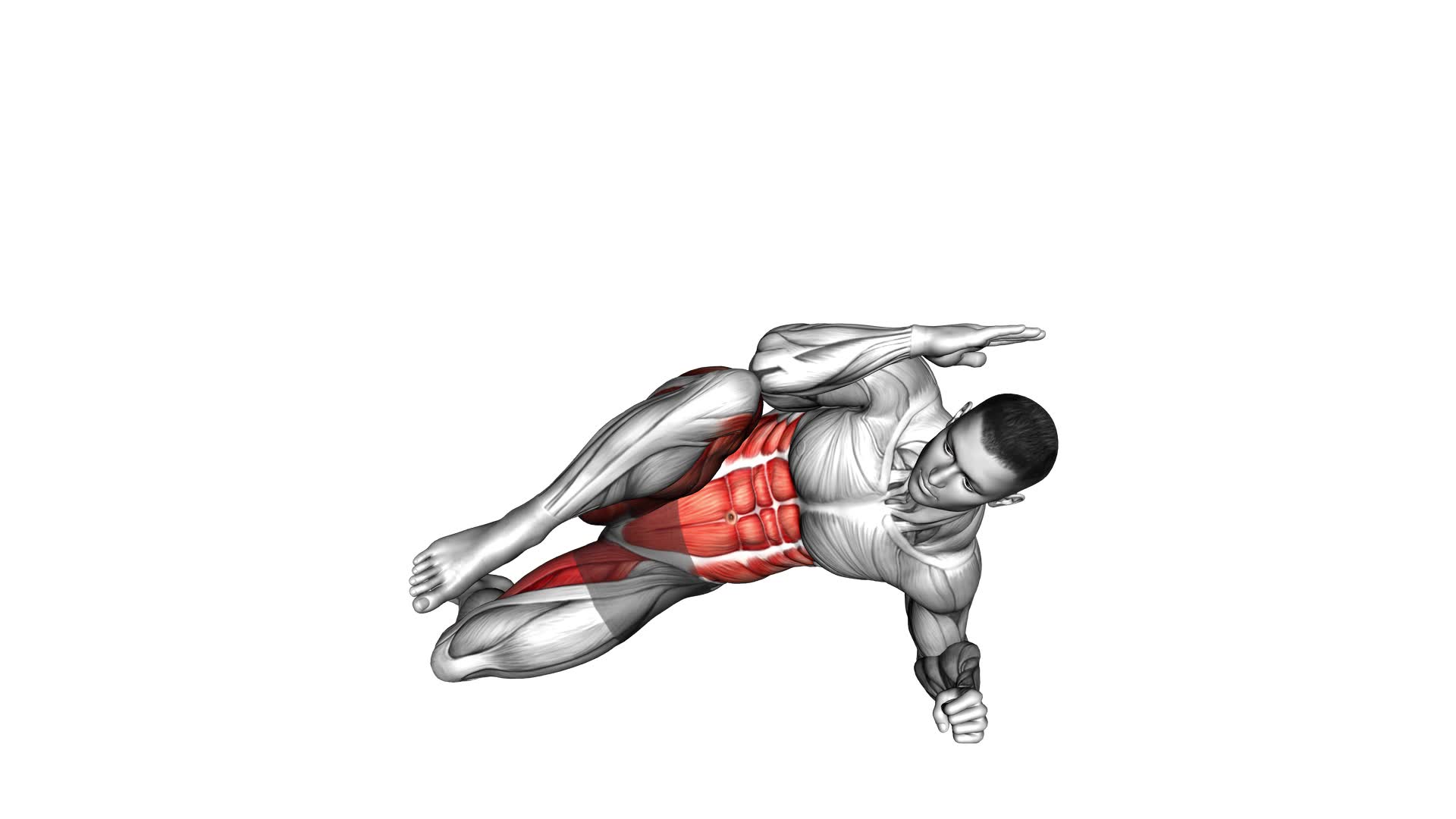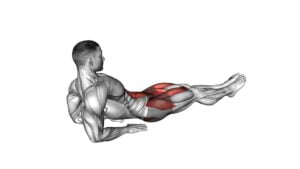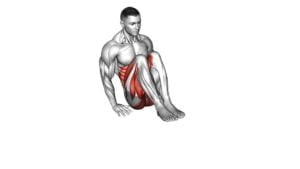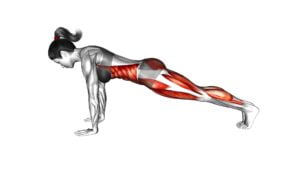Side Plank Knee Tuck (male) – Video Exercise Guide & Tips

Get ready to take your core workout to the next level with the Side Plank Knee Tuck. In this video exercise guide, we'll show you how to perform this challenging move with proper form and technique.
Watch This Exercise Video
Whether you're a beginner looking for modifications or an experienced individual seeking advanced variations, we've got you covered. Avoid common mistakes and maximize your results with our expert tips.
So grab a mat and get ready to strengthen and tone your abs like never before.
Key Takeaways
- Side Plank Knee Tuck improves core strength and stability.
- Engaging core muscles throughout the exercise is crucial for maximizing results and preventing injuries.
- Proper form and technique, such as maintaining a straight line from head to toe and avoiding sagging hips, are essential.
- Beginners can modify the exercise by starting with side plank on knees and gradually progressing to the traditional side plank on feet.
Benefits of the Side Plank Knee Tuck
You'll experience core strength and stability improvements with the Side Plank Knee Tuck. This exercise is an effective way to target your obliques, abs, and hip muscles. By performing the Side Plank Knee Tuck regularly, you can enhance your overall core strength and stability.
One of the benefits of the Side Plank Knee Tuck is its progression techniques. As you become more comfortable with the exercise, you can increase the difficulty by lifting your top leg or adding a stability ball under your feet. These progressions challenge your balance and engage your muscles even more.
Additionally, the Side Plank Knee Tuck can help prevent injuries. By strengthening your core, you reduce the risk of lower back pain and improve your posture. Strong obliques and abs also provide stability to your spine, reducing the likelihood of strains and injuries during activities that involve twisting or bending.
Proper form and technique are crucial for maximizing the benefits of the Side Plank Knee Tuck. In the next section, we'll discuss the correct way to perform this exercise to ensure you get the most out of it and reduce the risk of injury.
Proper Form and Technique
To perform the Side Plank Knee Tuck with proper form and technique, there are a few key points to keep in mind.
First, make sure to engage your core muscles throughout the exercise to maintain stability and control.
Secondly, be aware of common mistakes like sagging hips or collapsing shoulders, and focus on keeping your body in a straight line.
Lastly, if you're a beginner or find the exercise challenging, you can modify it by bending your bottom knee for added support.
Engaging Core Muscles
To effectively engage your core muscles, consistently perform the side plank knee tuck exercise with proper form and technique. Engaging your core muscles is crucial for core stability and overall strength. The side plank knee tuck exercise specifically targets your obliques, transverse abdominis, and rectus abdominis, which are key muscles for core stability.
To perform this exercise, start in a side plank position with your elbow directly under your shoulder and your legs extended. Then, bring your top knee towards your chest while maintaining a straight line from your head to your heels. As you bring your knee in, focus on contracting your abdominal muscles. Remember to keep your core engaged throughout the entire movement for maximum effectiveness.
Avoiding Common Mistakes
To avoid common mistakes and ensure proper form and technique, it's important that you focus on engaging your core muscles throughout the side plank knee tuck exercise.
This exercise primarily targets the obliques, hip flexors, and shoulders, so maintaining proper form is crucial for maximizing results and preventing injuries.
One common mistake to avoid is allowing your hips to sag or rotate during the exercise. To prevent this, engage your core by pulling your belly button towards your spine and keeping your body in a straight line from head to toe.
Additionally, be mindful of your breathing and avoid holding your breath.
Remember to incorporate recovery strategies such as stretching and foam rolling to prevent muscle imbalances and promote proper recovery.
Modifying for Beginners
If you're a beginner, modify the side plank knee tuck exercise to ensure proper form and technique. This modification is important for injury prevention and building strength effectively.
Start by performing the side plank on your knees instead of your feet. This will provide more stability and support for your core.
As you become more comfortable, gradually progress to the traditional side plank on your feet. Remember to engage your core muscles and keep your body in a straight line from your head to your knees or feet. Avoid sinking your hips or letting your body sag.
Focus on maintaining proper form and breathing throughout the exercise. By modifying the side plank knee tuck, you can safely and effectively build strength while reducing the risk of injury.
Modifications for Beginners
For beginners, try modifying the Side Plank Knee Tuck exercise by using an article determiner. This modification can help you gradually build strength and improve your stability before progressing to the full exercise.
To start, lie on your side with your legs extended and your elbow directly beneath your shoulder. Instead of lifting your top leg and bringing your knee towards your chest, you can begin by simply lifting your top leg a few inches off the ground. This will engage your core and activate the muscles needed for the Side Plank Knee Tuck.
Once you feel comfortable with this modification, you can gradually increase the range of motion by lifting your leg higher and bringing your knee closer to your chest. As you progress, you can also try holding the position for longer periods of time.
Remember to listen to your body and only progress to the next level when you feel ready. It's important to focus on proper form and control throughout the exercise to avoid any unnecessary strain or injury.
Advanced Variations for Experienced Individuals
Take your Side Plank Knee Tuck exercise to the next level with these advanced variations for experienced individuals. If you're looking to challenge your core and take your fitness to new heights, these advanced modifications are just what you need.
First, you can try the Side Plank Knee Tuck with a leg lift. Start in a traditional side plank position, with your forearm on the ground and your body in a straight line. From there, lift your top leg up towards the ceiling while keeping your core engaged. This variation adds an extra level of difficulty by targeting your obliques and hip muscles.
Another advanced modification is the Side Plank Knee Tuck with a twist. Begin in a side plank position and bring your top knee towards your chest. Instead of extending your leg back out, rotate your torso and bring your knee towards your opposite elbow. This movement engages your obliques and challenges your balance and coordination.
Remember to maintain proper form and engage your core throughout these advanced core exercises. By incorporating these variations into your workout routine, you'll continue to strengthen your core and improve your overall fitness level.
Now, let's move on to the next section and discuss common mistakes to avoid.
Common Mistakes to Avoid
Now let's explore some common mistakes to avoid when performing the Side Plank Knee Tuck exercise.
To ensure you're getting the most out of this exercise while avoiding injuries, it's important to maintain proper form and balance throughout.
One common mistake to avoid is allowing your hips to sag or drop during the exercise. This not only puts unnecessary strain on your lower back but also takes away from the effectiveness of the exercise. To prevent this, focus on engaging your core muscles and actively lifting your hips up towards the ceiling.
Another mistake to watch out for isn't properly aligning your body. Make sure your supporting arm is directly under your shoulder, and your body forms a straight line from head to toe. This will help you maintain balance and prevent any unnecessary strain on your joints.
Lastly, rushing through the exercise can lead to poor form and potential injuries. Take your time and focus on performing each movement with control and precision. This won't only help you avoid injuries but also ensure that you're targeting the correct muscles.
Tips for Maximizing Results
To maximize your results with the Side Plank Knee Tuck exercise, there are a few key points to keep in mind.
First, focus on finding the optimal workout frequency that works for you, whether it's incorporating this exercise into your routine a few times a week or every day.
Second, prioritize proper form techniques to ensure you're engaging the right muscles and avoiding injury.
Lastly, don't forget to implement essential recovery strategies such as stretching, foam rolling, and giving your body enough rest to allow for muscle growth and repair.
Optimal Workout Frequency
For optimal results, aim to work out at least three times a week.
Consistency is key when it comes to achieving your fitness goals. By working out regularly, you allow your body to adapt and improve over time.
When planning your workout frequency, consider the intensity of your workouts and the importance of rest periods. It's important to find a balance that works for you. High-intensity workouts may require more rest days in between to allow your muscles to recover and prevent overtraining. On the other hand, lower intensity workouts may allow for more frequent sessions.
Listen to your body and make adjustments as needed.
Proper Form Techniques
To maximize your results, focus on perfecting your form techniques during the Side Plank Knee Tuck exercise. Follow these tips to engage your obliques and ensure proper breathing techniques:
- Maintain a straight line from your head to your heels: Keep your body aligned by stacking your shoulder, hip, and ankle in one line. This will help you engage your obliques and prevent any unnecessary strain on your lower back.
- Squeeze your glutes and core: By engaging your glutes and core, you can stabilize your body and maintain the proper form throughout the exercise. This will also help you target your obliques more effectively.
- Breathe deeply and exhale on the knee tuck: Proper breathing techniques are essential to maximize your results. Breathe in deeply during the hold and exhale as you bring your knee towards your chest. This will help you maintain control and stability during the exercise.
Essential Recovery Strategies
Maximize your results by incorporating essential recovery strategies into your Side Plank Knee Tuck routine.
Recovery techniques are crucial for ensuring optimal performance and injury prevention. After completing your workout, it's important to cool down properly. This can include stretching exercises that target the muscles used during the exercise.
Additionally, taking the time to rest and allow your body to recover is essential. Adequate sleep and nutrition play a significant role in the recovery process. Make sure to fuel your body with nutritious foods and stay hydrated throughout the day.
Consider incorporating foam rolling or using a massage ball to help release tension and improve muscle recovery.
Frequently Asked Questions
How Many Calories Can I Burn by Doing the Side Plank Knee Tuck Exercise?
You can burn a significant amount of calories by doing the side plank knee tuck exercise.
This exercise engages your core muscles and requires stability, which can help increase your heart rate and burn calories.
However, the number of calories burned will vary depending on factors such as your weight, intensity, and duration of the exercise.
Beginners can modify this exercise by starting with a modified side plank or by performing knee tucks on the knees instead of the toes.
Can I Do the Side Plank Knee Tuck Exercise if I Have a History of Lower Back Pain?
If you have a history of lower back pain, it may be best to avoid the Side Plank Knee Tuck exercise. This exercise puts pressure on the lower back and could aggravate any existing pain or discomfort.
However, there are alternative exercises and modifications that can be done to target the same muscle groups without straining the lower back.
It's important to consult with a professional or personal trainer to find the best options for your specific needs.
How Often Should I Incorporate the Side Plank Knee Tuck Exercise Into My Workout Routine?
To incorporate the side plank knee tuck exercise into your workout routine, start by considering your fitness level and goals.
Beginners can modify the exercise by performing a regular side plank or knee tucks on the ground.
As you progress, you can add the knee tuck movement.
Aim to do this exercise 2-3 times a week, allowing your body time to recover.
Remember to maintain proper form and avoid common mistakes like sagging hips or rushing the movement.
Can I Perform the Side Plank Knee Tuck Exercise if I Have Weak Wrists?
If you have weak wrists, you may want to consider alternatives or modifications to the side plank knee tuck exercise. It's important to prioritize your safety and avoid any discomfort or pain.
There are various exercises that can target the same muscle groups without putting excessive strain on your wrists. Consulting with a fitness professional or physical therapist can help you find suitable options that align with your fitness goals and limitations.
Are There Any Specific Breathing Techniques I Should Follow While Doing the Side Plank Knee Tuck Exercise?
When performing the side plank knee tuck exercise, it's important to focus on your breathing technique. Take deep breaths in through your nose and exhale through your mouth. This will help you maintain control and stability throughout the movement.
For beginners, modifications can be made by starting with a modified side plank position and gradually working your way up to the knee tuck. Remember to listen to your body and take breaks as needed.
Conclusion
In conclusion, the side plank knee tuck is a highly effective exercise that targets multiple muscle groups and improves core strength and stability.
By following proper form and technique, beginners can modify the exercise to suit their fitness level, while experienced individuals can challenge themselves with advanced variations.
Avoiding common mistakes and incorporating these tips will help maximize results.
Incorporate this exercise into your routine for a stronger and more stable core.

Author
Years ago, the spark of my life’s passion ignited in my mind the moment I stepped into the local gym for the first time. The inaugural bead of perspiration, the initial endeavor, the very first surge of endorphins, and a sense of pride that washed over me post-workout marked the beginning of my deep-seated interest in strength sports, fitness, and sports nutrition. This very curiosity blossomed rapidly into a profound fascination, propelling me to earn a Master’s degree in Physical Education from the Academy of Physical Education in Krakow, followed by a Sports Manager diploma from the Jagiellonian University. My journey of growth led me to gain more specialized qualifications, such as being a certified personal trainer with a focus on sports dietetics, a lifeguard, and an instructor for wellness and corrective gymnastics. Theoretical knowledge paired seamlessly with practical experience, reinforcing my belief that the transformation of individuals under my guidance was also a reflection of my personal growth. This belief holds true even today. Each day, I strive to push the boundaries and explore new realms. These realms gently elevate me to greater heights. The unique combination of passion for my field and the continuous quest for growth fuels my drive to break new ground.







